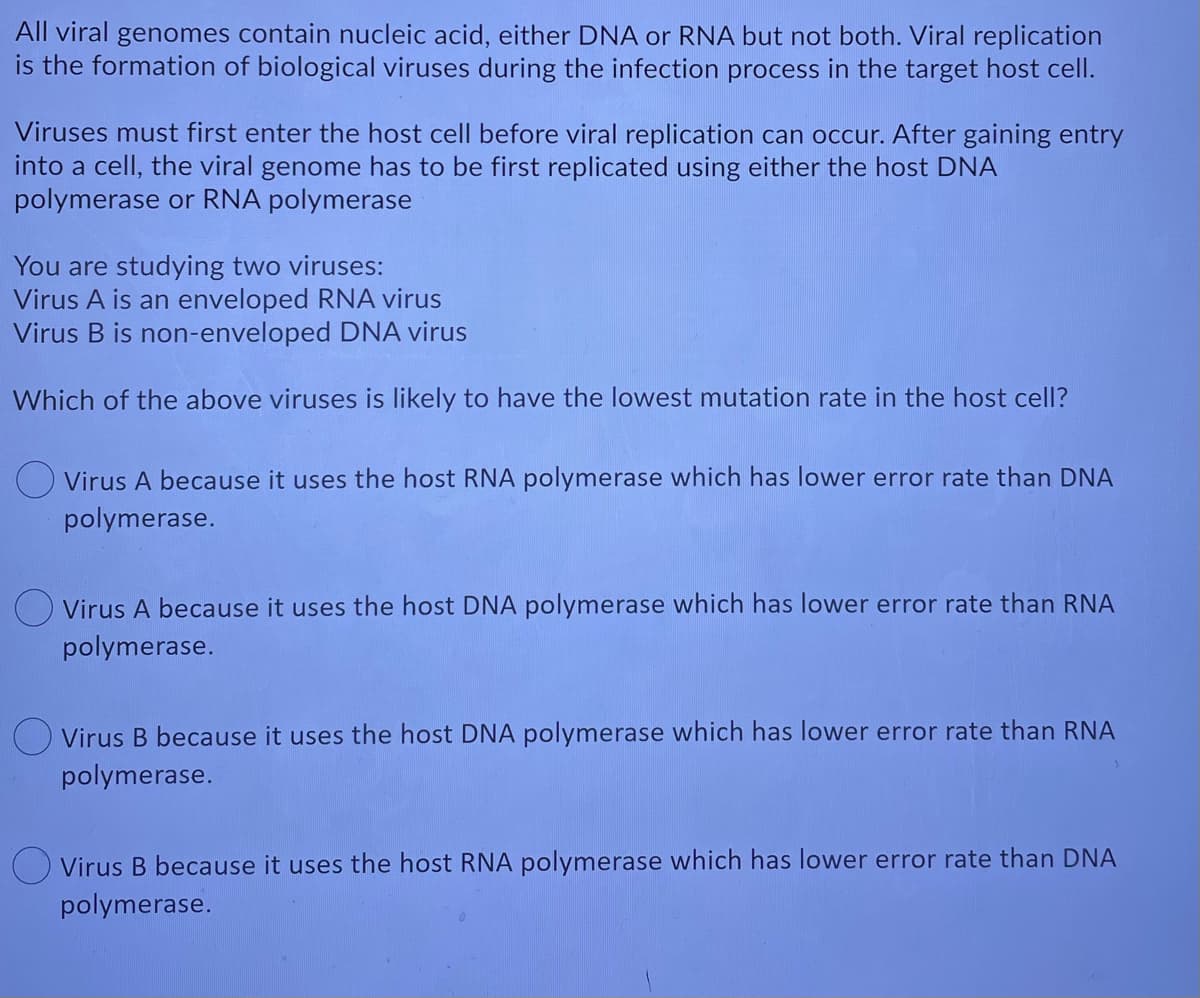All viral genomes contain nucleic acid, either DNA or RNA but not both. Viral replication is the formation of biological viruses during the infection process in the target host cell. Viruses must first enter the host cell before viral replication can occur. After gaining entry into a cell, the viral genome has to be first replicated using either the host DNA polymerase or RNA polymerase You are studying two viruses: Virus A is an enveloped RNA virus Virus B is non-enveloped DNA virus Which of the above viruses is likely to have the lowest mutation rate in the host cell? O Virus A because it uses the host RNA polymerase which has lower error rate than DNA polymerase. O Virus A because it uses the host DNA polymerase which has lower error rate than RNA polymerase. O Virus B because it uses the host DNA polymerase which has lower error rate than RNA polymerase. O Virus B because it uses the host RNA polymerase which has lower error rate than DNA polymerase.
All viral genomes contain nucleic acid, either DNA or RNA but not both. Viral replication is the formation of biological viruses during the infection process in the target host cell. Viruses must first enter the host cell before viral replication can occur. After gaining entry into a cell, the viral genome has to be first replicated using either the host DNA polymerase or RNA polymerase You are studying two viruses: Virus A is an enveloped RNA virus Virus B is non-enveloped DNA virus Which of the above viruses is likely to have the lowest mutation rate in the host cell? O Virus A because it uses the host RNA polymerase which has lower error rate than DNA polymerase. O Virus A because it uses the host DNA polymerase which has lower error rate than RNA polymerase. O Virus B because it uses the host DNA polymerase which has lower error rate than RNA polymerase. O Virus B because it uses the host RNA polymerase which has lower error rate than DNA polymerase.
Concepts of Biology
1st Edition
ISBN:9781938168116
Author:Samantha Fowler, Rebecca Roush, James Wise
Publisher:Samantha Fowler, Rebecca Roush, James Wise
Chapter17: The Immune System And Disease
Section: Chapter Questions
Problem 2ACQ: Figure 17.6 Influenza virus is packaged in a viral envelope, which fuses with the plasma membrane....
Related questions
Question
100%

Transcribed Image Text:All viral genomes contain nucleic acid, either DNA or RNA but not both. Viral replication
is the formation of biological viruses during the infection process in the target host cell.
Viruses must first enter the host cell before viral replication can occur. After gaining entry
into a cell, the viral genome has to be first replicated using either the host DNA
polymerase or RNA polymerase
You are studying two viruses:
Virus A is an enveloped RNA virus
Virus B is non-enveloped DNA virus
Which of the above viruses is likely to have the lowest mutation rate in the host cell?
O Virus A because it uses the host RNA polymerase which has lower error rate than DNA
polymerase.
O Virus A because it uses the host DNA polymerase which has lower error rate than RNA
polymerase.
O Virus B because it uses the host DNA polymerase which has lower error rate than RNA
polymerase.
O Virus B because it uses the host RNA polymerase which has lower error rate than DNA
polymerase.
Expert Solution
This question has been solved!
Explore an expertly crafted, step-by-step solution for a thorough understanding of key concepts.
Step by step
Solved in 2 steps

Knowledge Booster
Learn more about
Need a deep-dive on the concept behind this application? Look no further. Learn more about this topic, biology and related others by exploring similar questions and additional content below.Recommended textbooks for you

Concepts of Biology
Biology
ISBN:
9781938168116
Author:
Samantha Fowler, Rebecca Roush, James Wise
Publisher:
OpenStax College

Biology (MindTap Course List)
Biology
ISBN:
9781337392938
Author:
Eldra Solomon, Charles Martin, Diana W. Martin, Linda R. Berg
Publisher:
Cengage Learning

Concepts of Biology
Biology
ISBN:
9781938168116
Author:
Samantha Fowler, Rebecca Roush, James Wise
Publisher:
OpenStax College

Biology (MindTap Course List)
Biology
ISBN:
9781337392938
Author:
Eldra Solomon, Charles Martin, Diana W. Martin, Linda R. Berg
Publisher:
Cengage Learning